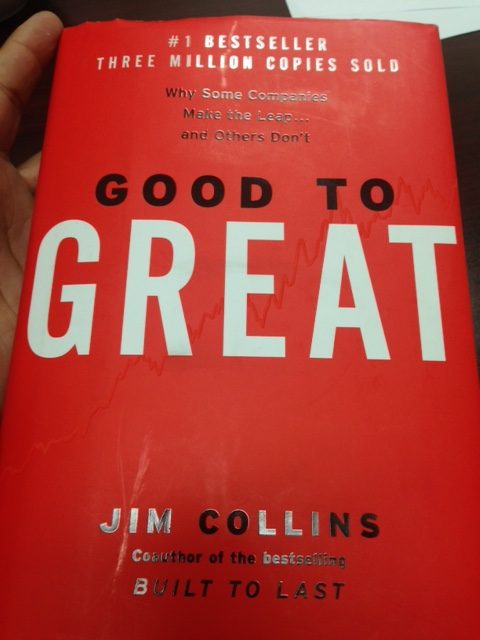Good to Great by Jim Collins
The Big Idea:
Chapter 1: Good is the Enemy of Great
- Good to Great companies always had Level 5 Leaders.
- Recruit the right people before choosing a direction/mission/vision/strategy.
- Confront the brutal truth and move forward anyways.
- Stick to your core.
- Create a culture of discipline.
- Use technology as an accelerator of existing greatness.
- Focus on small, continuous progress, not grand transformations.
Chapter 2: Level 5 Leadership
- Level 5 leaders are a paradoxical blend of personal humility and professional will.
- Level 5 leaders put their company and their team before themselves.
- Level 5 leaders are fanatical about results, not credit.
- Level 5 leaders come from within the company, not from outside.
- Level 5 leaders display workmanlike diligence, not celebrity charisma.
Chapter 3: First Who…Then What
- Hold out for the best talent. Don’t lower your hiring standards.
- Hire slow, fire fast. Then strive to zero turnover.
- Don’t rely on one genius leader. Have lots of great minds on board.
- There is no right answer for how to structure executive compensation. Just make sure it makes sense. The right people will deliver the best results, regardless of the compensation structure.
- You can create an environment that attracts the best people, but no compensation structure will turn poor performers into rock stars.
- Hire for attitude and character than for specific knowledge and skills.
- The best companies build great teams. They don’t work their people to the bone.
Chapter 4: Confront the Brutal Facts
- Don’t be afraid to look at the brutal facts.
- Create a culture that embraces truth and honesty.
- Ask a lot of question and engage in open dialogue.
- When something doesn’t work, take responsibility, figure out why but don’t blame others.
- Pay attention to key metrics so you know early when something is wrong.
- Regardless of the situation, have unwavering faith that the team will find a way to succeed.
- The three circles are: what are you deeply passionate about? What can you be the best in the world at? What drives your economic engine?
Chapter 5: The Hedgehog Concept
- Focus on the essentials and ignore the rest.
- You will success if you can identify one simple concept that is good and execute it fanatically.
- Eg. Walgreens key metric: profit per customer visit; Wells Fargo had profit per employee; Fannie Mae had profit per unit of risk; Kroger had profit per local population.
- Everyone has strategic plans, but the good-to-great companies are more likely to be based around a simple idea.
- Three key questions that define the hedgehog concept: what are you deeply passionate about, what can you be the best in the world, what drives your economic engine?
- Don’t focus on mindless pursuit of growth. Focus on your core business, defined by your hedgehog concept.
Chapter 6: A Culture of Discipline
- Startups often fail because they hire too many new people, acquire too many new customers, launch too many new products.
- Things become too complex and problems start to surface.
- Fast-growing startups will hire professional managers to reign in the mess, but also kill the entrepreneurial spirit.
- Instead of installing bureaucracy to compensate for incompetence and lack of discipline, hire the right people in the first place.
- Avoid bureaucracy and hierarchy and instead create a culture of discipline.
- Build a culture around the idea of freedom and responsibility, within a framework.
- Fill that culture with self-disciplined people who are willing to go to extreme lengths to fulfill their responsibilities.
- Create a stop-doing list and focus on the hedgehog concept.
- Develop a system and manage the system. Don’t manage the people.
- Culture beats great individual leadership.
- A culture of discipline prevents you from expanding outside of your core.
- A culture of discipline prevents you from an inflated overhead and layers of waste.
Chapter 7: Technology Accelerators
- Be selective about which technologies you adopt.
- Make sure your technology supports your hedgehog concept.
- Technology by itself is never the primary cause of success or failure.
- Reliance on technology can give you a false sense of invulnerability.
Chapter 8: The Flywheel and the Doom Loop
- Success is an organic, cumulative process. It never happens overnight.
- Success takes patience and discipline.
- Focus on continuous, incremental improvement, not miraculous transformations.
- Once there is visible progress, keep the momentum going. It is infectious.
Chapter 9: From Good to Great to Built to Last
- The central concept of Built to Last: discover your core values and purpose beyond just making money (core ideology) and combine this with the dynamic of preserve the core/stimulate progress.
- Hewlett Packard started with “who” before ever deciding what they would build (“what”.)
- Walmart had taken 25 years to get to 38 stores, patiently defining their hedgehog concept.
- Profits and cash flow are like blood and water. They are necessary for life, but they are not the purpose of living.
- Built To Last 1. Clock Building not Time Telling: culture and systems > single great leader/idea
- Built to Last 2. Genius of AND: purpose AND profit, continuity AND change
- Built to Last 3. Core Ideology: core values and purpose
- Built to Last 4. Preserve the Core/Stimulate Progress: (except for core values) constant change, innovation, experimentation
